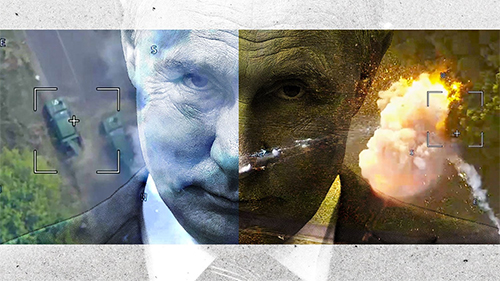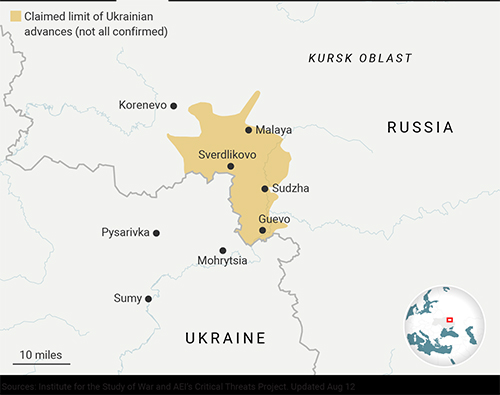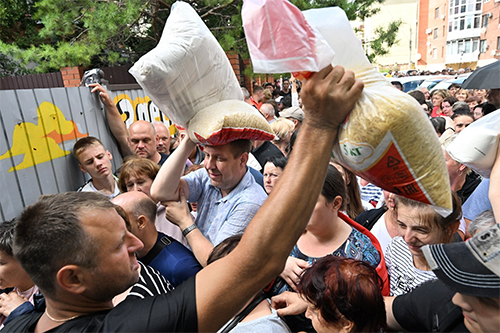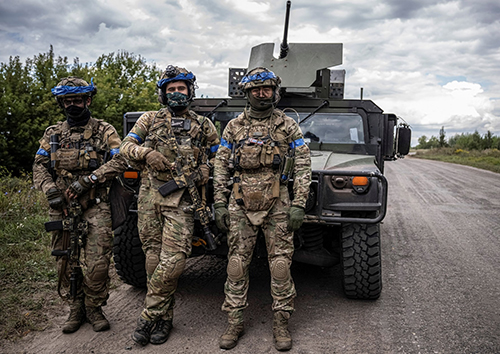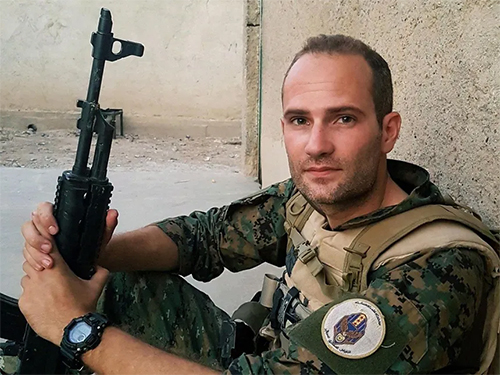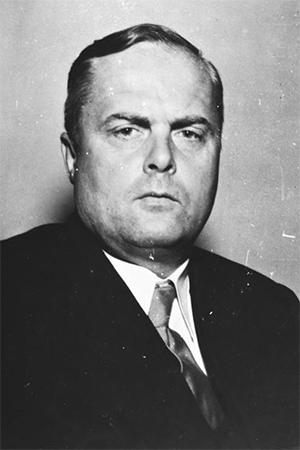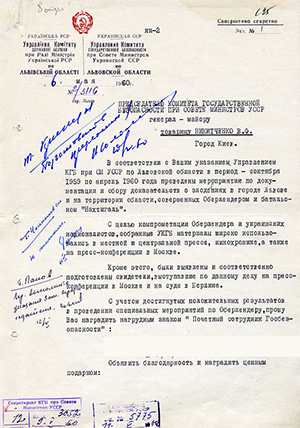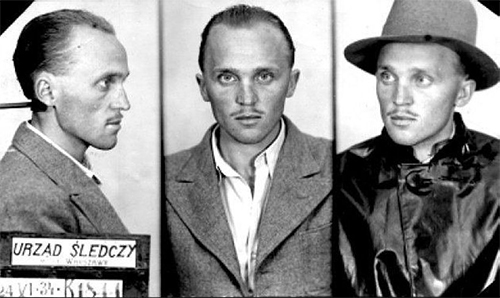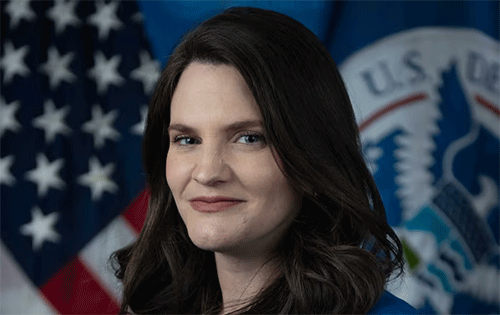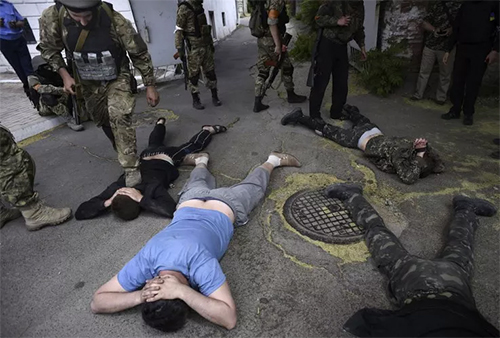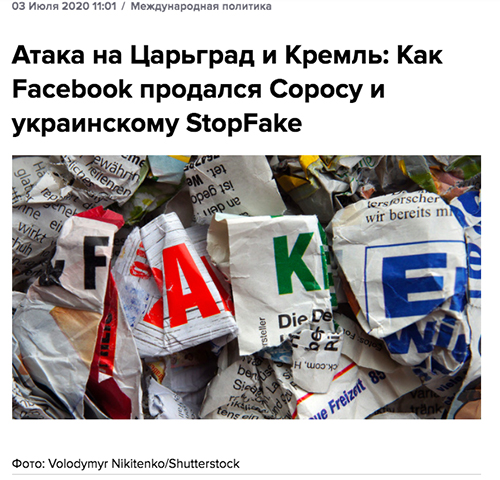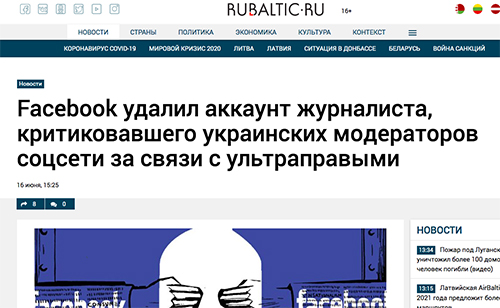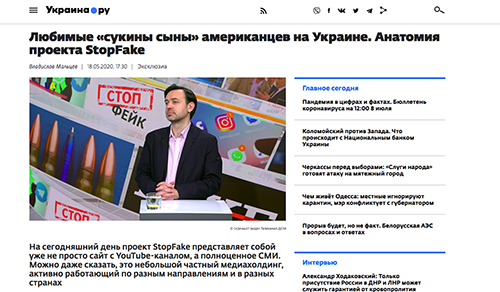by Wikipedia
Accessed: 8/31/24
https://en.wikipedia.org/wiki/Nachtigall_Battalion
Nachtigall Battalion
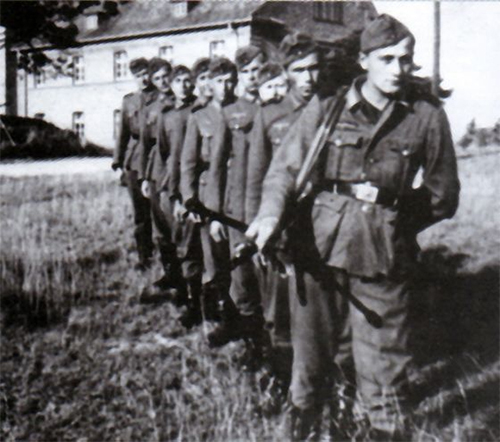
February, 1941.
Active: February 25 – late October 1941
Country: Nazi Germany; Reichskommissariat Ukraine
Branch: Abwehr
Role: Special Forces
Size: 360 to 400
Engagements: Operation Barbarossa
Commanders
Notable commanders: Roman Shukhevych, Theodor Oberländer
The Nachtigall Battalion (English: Nightingale Battalion), also known as the Ukrainian Nightingale Battalion Group (German: Bataillon Ukrainische Gruppe Nachtigall), or officially as Special Group Nachtigall[1] (German: Sondergruppe 'Nachtigall'[2]) was a subunit under command of the German Abwehr special-operations unit Lehrregiment "Brandenburg" z.b.V. 800 in 1941. Along with the Roland Battalion it was one of two military units which originated on February 25, 1941, when the head of the Abwehr, Admiral Wilhelm Franz Canaris, sanctioned the formation of a "Ukrainian Legion"[3] under German command. The Legion was composed of volunteer Ukrainians many of whom were members or supporters of Organization of Ukrainian Nationalists (OUN-B).[4] The Battalion participated in early stages of Operation Barbarossa (the Axis invasion of the Soviet Union) with Army Group South[5] between June and August 1941.
After returning to Germany, in November 1941 the Ukrainian members of the Legion were reorganized into the 201st Schutzmannschaft Battalion. It numbered 650 persons who served for one year in Byelorussia (present-day Belarus) before disbanding.[6] Many of its members, especially the commanding officers, went on to join the Ukrainian Insurgent Army (founded in 1942), and 14 of its members joined SS Division Galicia in spring 1943.[7]
Formation and training
Prior to Operation Barbarossa, the Stepan Bandera's Organization of Ukrainian Nationalists (OUN) sought contact with Nazi Germany and in fact received its training there in order to use this as an opportunity to restore independence of Ukraine.[citation needed]
According to the National Academy of Sciences of Ukraine and other sources, OUN-B leader Stepan Bandera held meetings with the heads of Germany's intelligence, regarding the formation of the Nachtigall and Roland Battalions. February 25, 1941, Wilhelm Canaris, head of the Abwehr, sanctioned the creation of the "Ukrainian Legion" under German command. The unit would have had[vague] 800 persons. Roman Shukhevych became a commander of the Legion from the OUN-B side.[vague] OUN expected that the unit would become the core of the future Ukrainian army. In the spring the OUN received 2.5 million marks for subversive activities against the USSR.[8][9][verify] In the spring of 1941 the Legion was reorganized into two units. One of the units became known as Nachtigall Battalion, a second became the Roland Battalion.[citation needed]
Training for Nachtigall took place in Neuhammer near Schlessig. On the Ukrainian side, the commander was Roman Shukhevych and on the German, Theodor Oberländer. (Oberländer was later to become Federal Minister for Displaced Persons, Refugees and War Victims in the Federal Republic of Germany.) Ex-Brandenburger Oberleutnant Dr. Hans-Albrecht Herzner (de) was placed in military command of the Battalion.[citation needed]
The Nachtigall unit was outfitted in the standard Wehrmacht uniforms. Before entering Lviv, they placed blue and yellow ribbons on their shoulders.[10][verify]
War with the Soviet Union
Four days before the attack on the Soviet Union, the Battalion was moved to the border. On the night of June 23–24, 1941, the Battalion crossed the border near Przemyśl while traveling in the direction of Lviv. The Nachtigall Battalion traveled along with a Panzer-Jaeger Division[dubious – discuss] and some tank units went along through Radymno-Lviv-Ternopil-Proskuriv-Vinnytsia path.[11][verify] As part of the 1st Brandenburg Battalion, the first soldiers of the Nachtigall Battalion entered Lviv on June 29.[12] The battalion took up guard of strategic objects, the most important of which was the radio station on the Vysoky Zamok Hill in the centre of Lviv. From the radio station, the proclamation of the Act of Ukrainian Independence was made.[4]
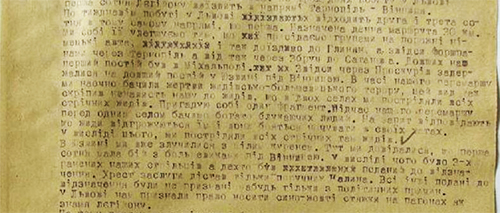
Excerpt from a report by a member of the battalion about shooting "all Jews which were met" in Vinnytsia region
The Nachtigall servicemen participated in and organized the Declaration of Ukrainian Independence proclaimed by Yaroslav Stetsko on June 30. Battalion chaplain Ivan Hrynokh made a speech after declaration meeting ended. The German administration did not support these activities but did not act harshly against organizers until mid-September 1941.[13][verify]
The first company of the Nachtigall Battalion left Lviv with the Brandenburgers on July 7 in the direction of Zolochiv. The remainder of the unit joined later during their eastward march towards Zolochiv, Ternopil and Vinnytsia.[4] The unit participated in action against Stalin Line where some of its members were awarded by the Germans. During the march at three villages of the Vinnytsia region "all Jews which were met" were shot.[14][verify]
The German refusal to accept the OUN(b)'s June 30 proclamation of Ukrainian independence in L'viv led to a change of the Nachtigall battalion direction. As the result, the battalion was recalled to Cracow and disarmed on August 15. It was later transformed together with Roland battalion into the 201st Schutzmannschaft Battalion.[15][16][verify]
Assessment
Russian historian Sergei Chuyev states that despite the ending, OUN achieved its ultimate goals – 600 members of their organization had received military training and had battle experience and these men took positions as instructors and commanders in the structure of the newly formed Ukrainian Insurgent Army.[17][verify]
Stepan Bandera wrote: "The end of OUN was such: the revolutionary columns were commanded by Roman Shukhevych with a small party of officers who had not only undergone military training but had come to a clear understanding of military tactics. Most importantly, they brought with them - an understanding of organization, strategies and tactics of partisan fighting, and the German method of dealing with partisan groups. This knowledge was very useful in the formation and activities of the UPA and in its future conflicts.[17][verify]
During its short history, the Nachtigall Battalion had 39 casualties and 40 wounded soldiers.[17][verify]
Controversy
https://rapeutation.com/ninajanc2c.gif
KGB document on action against Theodor Oberländer and Ukrainian Nachtigall (1959).[18][19]
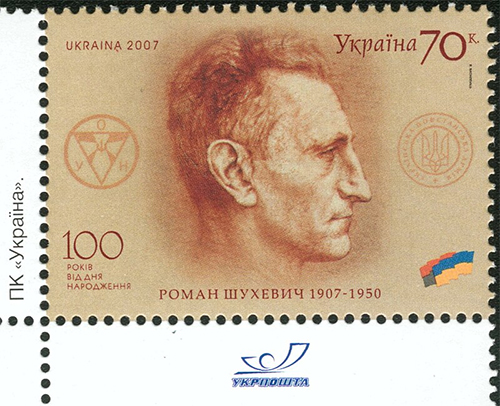
A Ukrainian postage stamp (2007) honouring the Ukrainian Commander of the Nachtigall Battalion - Roman Shukhevych on the 100th anniversary of his birth
Main article: Controversy surrounding the Lviv pogroms of 1941
Accusations have placed the Battalion in Lviv in July 1941 and claimed that the unit participated in the pogrom that took place. Some members of the unit did indeed participate in the pogrom, which implicates the unit as a whole.
World opinion: An international commission was set up at The Hague in the Netherlands in 1959 to carry out independent investigations. The members were four former anti-Hitler activists, Norwegian lawyer Hans Cappelen, former Danish foreign minister and president of the Danish parliament Ole Bjørn Kraft, Dutch socialist Karel van Staal, Belgian law professor Flor Peeters, and Swiss jurist and member of parliament Kurt Scoch. Following its interrogation of a number of Ukrainian witnesses between November 1959 and March 1960, the commission concluded: "After four months of inquiries and the evaluation of 232 statements by witnesses from all circles involved, it can be established that the accusations against the Battalion Nachtigall and against the then Lieutenant and currently Federal Minister Oberländer have no foundation in fact".[20]
The Ukrainian side[vague] states that none of the allegations have been proven by any documents and that the Battalion's main priority was securing the radio station, newspapers and proclaiming Ukrainian independence.[21]
Canadian Investigation: The Canadian Commission on War Criminals in Canada (Deschênes Commission) that look into allegations of war criminals residing in Canada, has not named any of the members of the Nachtigall Battalion. Moreover, it concluded, that units collaborating with the Nazis should not be indicted as a group and that mere membership in such units was not sufficient to justify prosecution.[22]
Yad Vashem's Encyclopedia of the Holocaust contends that between June 30 and July 3, 1941, in the days that the Battalion was in Lviv, the Nachtigall soldiers together with the German army and the local Ukrainians participated in the killings of Jews in the city. The Encyclopedia of the Holocaust states that the unit was removed from Lviv on July 7 and sent to the Eastern Front.[23]
The Polish side[vague] contends that members of the Nazi-led Nachtigall battalion also participated in the massacres of Polish professors, including the ex-Polish Prime minister Kazimierz Bartel, Tadeusz Boy-Żeleński and others, in Lwów in 1941. See Massacre of Lviv professors. [citation needed]
References
1. Abbot, Peter. Ukrainian Armies 1914-55, p.47. Osprey Publishing, 2004. ISBN 1-84176-668-2
2. Boli︠a︡novsʹkyĭ, Andriĭ (2003). Українські військові формування в збройних силах Німеччини, 1939-1945 [Ukrainian military formations in the armed forces of Germany, 1939-1945]. Lviv: Львівський національний університет ім. Івана Франка. p. 571. ISBN 9789666132195. Retrieved 24 November 2022. During April-June 1941, Abwehr organized again two new Battalions mostly from adherents of OUN-B : Special group 'Nightingale'" (Sondergruppe 'Nachtigall' ) and Organization 'Roland' [...].
3. Not to be confused with the Ukrainian Legion of Self-Defense founded in 1943.
4. J
І.К. Патриляк. Військова діяльність ОУН(Б) у 1940—1942 роках. Archived 2016-11-04 at the Wayback Machine — Університет імені Шевченко \Ін-т історії України НАН України Київ, 2004 (No ISBN) p.271-278.
5. Melnyk, Michael James (17 May 2017). "The Crucible of a Nation State". The History of the Galician Division of the Waffen SS: On the Eastern Front: April 1943 to July 1944. Fonthill Media. ISBN 9781781555286. Retrieved 24 November 2022. When Germany invaded the Soviet Union, Roland advanced into Southern Bessarabia and Nachtigall crossed into Galicia with Army Group South.
6. І.К. Патриляк. Військова діяльність ОУН(Б) у 1940—1942 роках. — Університет імені Шевченко \Ін-т історії України НАН України, Київ, 2004 (No ISBN) pp 371-382.
7. Боляновський А.В. Дивізія «Галичина»: історія — Львів: , 2000.
8. І.К. Патриляк. Військова діяльність ОУН(Б) у 1940—1942 роках. — Університет імені Шевченко \Ін-т історії України НАН України Київ, 2004 (No ISBN) p.273-275
9. Організація українських націоналістів і Українська повстанська армія. Інститут історії НАН України.2004р Організація українських націоналістів і Українська повстанська армія, Раздел 1 "Archived copy" (PDF). Archived from the original (PDF) on July 17, 2011. Retrieved September 1, 2009. стр. 17-30
10. І.К. Патриляк. Військова діяльність ОУН(Б) у 1940—1942 роках. — Університет імені Шевченко \Ін-т історії України НАН України Київ, 2004 (No ISBN)
11. І.К. Патриляк. Військова діяльність ОУН(Б) у 1940—1942 роках. — Університет імені Шевченко \Ін-т історії України НАН України Київ, 2004 [I.K Patrylyak (2004): Military activities of the OUN (B) in the years 1940-1942.] Kiev, Ukraine: Shevchenko University \ Institute of History of Ukraine National Academy of Sciences of Ukraine. pp. 300-311
12. Дружини українських націоналістів у 1941 — 1942 роках. — Без місця видання, 1953. — С. 6, 109 — 110. (Teams of Ukrainian Nationalists in 1941-42 - 1953, 109)
13. ОУН в 1941 році: документи: В 2-х ч Ін-т історії України НАН України К. 2006 ISBN 966-02-2535-0
14. "... скрепив нашу ненависть нашу до жидів, що в двох селах ми постріляли всіх стрічних жидів. Під час нашого перемаршу перед одним селом... ми постріляли всіх стрічних там жидів" from Nachtigal third company activity report Центральний державний архів вищих органів влади та управління України (ЦДАВО). — Ф. 3833 . — Оп. 1. — Спр. 157- Л.7
15. Дружини українських націоналістів у 1941 — 1942 роках. — Без місця видання, 1953. — С. 110 — 110. (Teams of Ukrainian Nationalists in 1941-42 - 1953, 110 "По нараді з командиром Р.Шухевич вислав письмо до Команди що наша частина не є здібна дальше воювати. Цілий легіон було стягнено з фронту та відправлено назад до Нойгаммеру
16. Ivan Kazymyrovych Patryliak, Viis'kova diial'nist' OUN(b) u 1940-1942 rokakh (Kyiv: NAN Ukraïny, 2004) p 361-362
17. (in Russian) Chuyev, Sergei Ukrainskyj Legion - Moskva, 2006 pp. 179-184
18. [1].(ГДА СБУ фонд 1, опис 4 за 1964 рік, порядковий номер 3, том 5, аркуш 195 Розсекречено: 24/376 від 05.02.2008 р. - original sygnature of document).
19. In accordance with your indication of the Office of the KGB under the Council of Ministers of the Ukrainian SSR in Lviv region in the period from October 1959 to April 1960 measures were taken to document and collect evidence of atrocities in the city of Lviv and the region, committed by Oberländer and the battalion "Nachtigall". In order to compromise Oberlander and Ukrainian nationalists, KGB collected materials are widely used in the local and national press, newsreel and the press-conference in Moscow. In addition, they have been identified and trained accordingly witnesses who spoke of the case at a press conference in Moscow on the court in Berlin. Given the positive results achieved in the special events on Oberlander, I ask you to award the badge "Honorary Officer of State Security" (name not disclosed) Declare gratitude and reward valuable gift.
20. Alfred M. de Zayas, The Wehrmacht War Crimes Bureau, 1939-1945 , University of Nebraska Press, Lincoln and London, 1979, pp. 214-227
21. "The history which we do not know or do not want to know - Dzerkalo Tyzhdnia" (in Ukrainian). Archived from the original on 2010-06-17. Retrieved 2007-11-11.
22. Wasyl Veryha. Along the Roads of World War II. War Criminals in Canada? (Commission of Inquiry on War Criminals Report) Archived 2007-07-02 at the Wayback Machine
23. ""Ukrainian Military Unit" ,Encyclopedia of the Holocaust [1990]. Macmillan Publishing Company: New York, 1990". motlc.learningcenter.wiesenthal.org. 28 September 2007. Archived from the original on 12 February 2008. Retrieved 6 July 2023.
Sources
• (in Russian) Chuyev, Sergei Ukrainskyj Legion - Moskva, 2006
• Ukrainians in the military during World War II
Categories:
• Abwehr
• Foreign volunteer units of the Wehrmacht
• Organization of Ukrainian Nationalists
• The Holocaust in Poland
• The Holocaust in Ukraine
• Military history of Germany during World War II
• Local participation in the Holocaust
• Ukrainian collaborators with Nazi Germany
• Military units and formations established in 1941
• Military units and formations disestablished in 1941

